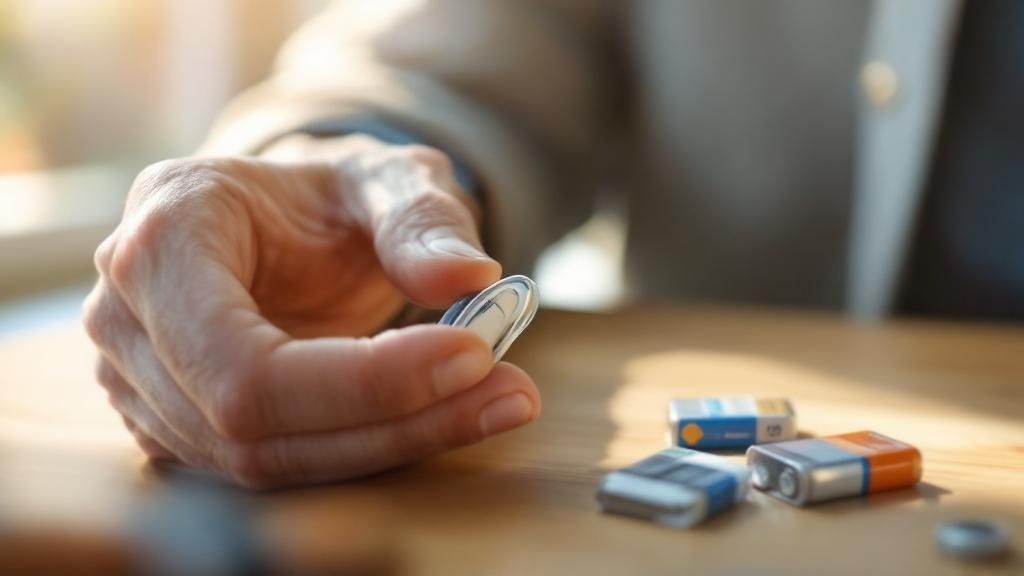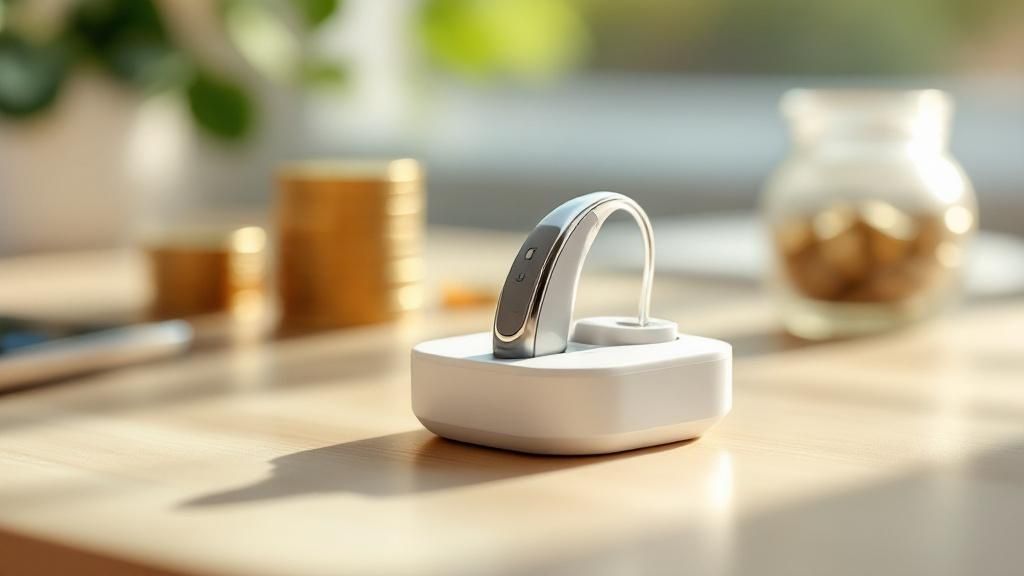That familiar silence. One moment you're part of the conversation, the next, the world fades to a frustrating mumble. It’s a feeling every hearing aid user knows. The culprit? A tiny, metallic disc that has run out of power.
Changing it seems simple. Open the door, pop it out, slide a new one in. But what if I told you there’s a hidden step—a moment of patience most people skip—that could unlock days of extra life from every single battery?
Mastering this tiny ritual isn’t just about power; it’s about reclaiming your connection to the world without interruption. Let’s begin.
From Silent Disc to Sonic Heartbeat

Imagine that tiny battery as the very heartbeat of your hearing aid. It’s the invisible engine that transforms a muffled world into a symphony of crisp conversations and clear, vibrant sounds. When it fades, your world feels distant, muted.
But what if you could turn this chore into a confident, empowering routine? What if you held the key to making each battery last longer than the last? It all starts with a secret hidden in plain sight: a flash of color.
From Confusion to Clarity: The Universal Color Code
Forget squinting at impossibly small numbers. The hearing aid world has a beautiful, simple secret: a universal color code. That little colored tab on your battery isn't just for decoration; it's a language. Your language.
Once you know your color, you’ll never feel that flicker of doubt in the store aisle again. You'll see your color, and you'll know. It’s the first step from fumbling with a dead device to confidently restoring its power.
Your Color, Your Power: A Quick Guide to Certainty
| Battery Size | Color Code | The World It Powers… |
|---|---|---|
| 10 | Yellow | The Tiniest Devices (CIC, Invisible) |
| 312 | Brown | The Most Common (ITC, RIC) |
| 13 | Orange | The Classic Powerhouses (BTE, ITE) |
| 675 | Blue | The Ultimate Performers (Power BTE) |
But identifying your color is just the beginning of the story. The real magic happens next.
A single, overlooked pause separates a battery that dies quickly from one that thrives. It’s a secret hidden in the air we breathe.
The Five-Minute Secret That Changes Everything
Those little batteries are called zinc-air for a reason. They sleep, inert and waiting, until the moment you peel back that tiny sticker. This isn't just removing a seal; it’s an awakening. Air rushes in through microscopic holes, meeting the zinc inside and sparking a chemical reaction that creates power.
And here is the mistake nearly everyone makes: they rush. They peel the tab and immediately slam the battery door shut, starving the battery of the very oxygen it needs to come to full power.
Instead, try this. Peel the tab. Place the battery on a table. And wait. For three to five minutes. Let it breathe. In this small moment of patience, the battery inhales, activating fully and reaching its peak potential. This simple pause can add hours, even days, to its life.
While you wait, it’s the perfect moment for another small ritual: a quick, gentle cleaning. Discover how in our guide on how to clean hearing aids.
Embrace this pause. It’s the difference between a battery that merely works and a battery that endures.
The Ritual of Renewal: From Silence to Sound

Feel the device in your hand. This isn't just a piece of technology; it's your connection. Changing the battery is a precise, personal ritual. With time, your thumb learns the exact curve of the battery door, the gentle pressure that swings it open.
Listen for the soft, satisfying click as the compartment releases. This isn't a task to be rushed. It’s a moment of focus that transforms a clumsy fumbling into a smooth, confident motion. You are in control.
From Fumbling Fingers to Flawless Execution
With the door open, a gentle tip is all it takes. Gravity releases the spent battery. Now, for the new one, alive and breathing after its five-minute awakening. That little tab is your handle. Use it. Guide the fresh battery toward its new home.
Look closely. You’ll see a tiny ‘+’ symbol. This is your compass. This positive side must face up, open to the world. Getting this orientation right is the final, critical piece of the puzzle. It ensures the circuit is complete.
This simple infographic transforms a confusing jumble of models into a simple, color-coded choice.

With the right battery in hand, gently press it into its slot. It should settle in without a fight. Now, swing the door closed. Listen for that final, reassuring click. It’s the sound of connection restored.
With each successful change, you aren’t just replacing a power source. You’re reopening the door to every laugh, every whisper, every note of music. It's a simple skill that holds the key to an uninterrupted life.
This need for a reliable connection is universal. The global hearing aid battery market was valued at USD 1.6 billion in 2023 and is soaring. You can discover more insights about this expanding market and witness the future of hearing technology unfold.
The Unseen Forces That Drain Your Battery's Life

Does it feel like you’re feeding your hearing aids batteries far too often? It’s a quiet frustration, but the power to change it is in your hands. Small, invisible habits are the silent thieves of battery life, stealing power when you aren't looking.
The most common culprit? The environment itself. That humid bathroom where you get ready? It’s a battery’s worst enemy. Moisture seeps into the delicate chemistry, slowly and silently shortening its life.
From Power Drain to Power Gain: Small Shifts, Big Results
Your ally is a cool, dry place away from the sun’s glare—a simple bedside drawer is a fortress of longevity. Extreme temperatures are just as sinister. A hot car or a freezing windowsill forces the battery into overdrive, exhausting it prematurely.
But the single most powerful habit you can build costs nothing and takes only a second. Every single night, open the battery door fully. This tiny action is like flipping a switch, completely disconnecting the battery and stopping the slow, silent drain of power overnight. Over a year, this simple act can save you entire packs of batteries.
This gesture does more than save power. It allows air to circulate, evaporating any moisture that accumulated during the day, protecting both your battery and your device.
These small shifts in your routine are not just chores; they are acts of preservation, ensuring your hearing aids are always ready for you.
From Battery Killer to Battery Saver: Your New Playbook
| The Unconscious Mistake (Battery Killer) | The Intentional Habit (Battery Saver) |
|---|---|
| Storing them in a steamy bathroom. | Giving them a cool, dry home in a drawer. |
| Leaving the battery door shut overnight. | Opening the door wide every single night. |
| Exposing them to a hot car or cold sill. | Keeping them at a stable room temperature. |
| Grabbing batteries from the newest pack. | Using the "first-in, first-out" strategy. |
By consciously choosing the habits on the right, you seize control, turning frustration into foresight and getting more life from every single cell.
The Future is Now: Smart Storage and Rechargeable Freedom
Even the way you store your supply matters. When you buy a new package, place it behind your current one. This "first-in, first-out" method ensures you’re always using the freshest batteries first, respecting their shelf life.
Of course, the ultimate power move is to sidestep disposable batteries entirely. The market for rechargeable hearing aids is projected to hit an incredible USD 5.1 billion by 2033. Why? Sheer, unadulterated convenience.
For those of us still mastering disposables, these small adjustments are game-changers. For a deeper dive, explore our guide on maximizing hearing aid battery life. Adopt these habits, and you won’t just save money—you’ll gain the priceless peace of mind that comes from a power source you can truly trust.
The Art of Diagnosis: When a New Battery Isn't the Answer

That sudden, jarring silence. Your hearing aid is dead. You just put in a fresh battery, so your mind races. Is the device broken? Don't panic. Before you assume the worst, let's become a detective.
The most common suspect, surprisingly, is the new battery itself. It’s rare, but even factory-sealed batteries can be duds. So, the very first step is simple: remove it and try another one from the exact same pack.
If the second one also fails, the plot thickens. Is it a bad batch? Before you decide, open a completely new package of batteries and try one from there. This simple process of elimination can save you a world of worry.
The Clues Are Right in Front of You
So, you've confirmed the batteries aren't the problem. What's next? A visual inspection. Open the battery door and gaze at the metal contacts where the battery rests. Are they gleaming and bright? Or do you see a dullness, a discoloration, even a hint of crust?
Over time, wax, moisture, and debris can build a corrosive barrier, blocking the flow of electricity. If you see this, gently—very gently—clean the contacts with a dry, clean cloth or a fresh cotton swab. Never use water or cleaning solutions. You'll turn a simple problem into a catastrophic one.
Here’s a trick the pros use: the "cupping test." Place the hearing aid in your palm and cup your other hand over it. If it’s working, you’ll hear a high-pitched whistle—that’s feedback. Silence points directly to a power issue.
This two-second test can tell you everything you need to know.
From Self-Reliance to Seeking an Expert
You’ve tried fresh batteries from different packs. You’ve gently cleaned the contacts. You’ve done the cupping test, and all you hear is silence. Now, the investigation shifts. The problem may lie deeper, in a blocked microphone or a failed internal component.
This is the moment to stop. Our comprehensive hearing aid troubleshooting guide offers more steps you can take, but if you've exhausted them, it's time to call for backup.
Your hearing health professional possesses the specialized tools and knowledge to diagnose the unseen. They can solve the mystery and restore the sound, ensuring your device gets the expert care it deserves.
The Final Journey: What to Do With a Spent Battery
A hearing aid battery’s life is finite. It has pulsed with energy, bringing the world to your ears. But when its power is gone, its journey is not over. Tossing it into the trash feels easy, but that tiny cell carries materials that don't belong in our earth.
Think of it as the final act of care. Your commitment to hearing well can be beautifully paired with a commitment to our planet's health. Disposing of your batteries correctly is the last, crucial step in the ritual.
The Hidden Impact of a Tiny Disc
Most disposable batteries are zinc-air, but they contain trace elements that can be harmful if they leach into the soil and groundwater from a landfill. It seems like a small act, but when millions of us do it, the impact is immense.
The beautiful part? Recycling them is surprisingly simple. Communities and retailers have made it easier than ever to do the right thing, ensuring these materials are recovered and reused safely.
Proper disposal isn't a chore; it's an act of stewardship. You are ensuring the tool that connects you to your world doesn’t disconnect us all from a healthier environment.
Your Map to Responsible Recycling
So where do you take these spent cells? Your options are more convenient than you might imagine.
- Local Electronics Stores: Chains like Best Buy often have recycling kiosks waiting right by the entrance. Just drop them in as you pass by.
- Your Audiologist's Office: Many clinics collect used batteries as a courtesy to their patients. Simply bring them to your next appointment.
- Mail-In Programs: Some manufacturers offer programs that let you recycle from the comfort of your home.
Here's a simple life hack: keep a small, sealed container, like an old pill bottle, for your used batteries. When it's full, you can take them all in one go. Make it part of your routine, and you’ll be closing the loop responsibly every single time.
Your Questions, Answered with Clarity
Even with a newfound mastery, questions will arise. You're not alone in your curiosity. Here are the answers to the most common questions we hear, designed to give you complete and total confidence in managing your hearing aid's power.
How Do I Know When My Hearing Aid Battery Is Dying?
Your hearing aid will speak to you. Most modern devices give an audible warning—a series of gentle beeps or even a spoken phrase. If you're connected to a smartphone app, it will often flash a notification on your screen.
But there are subtler tells. Does the sound feel weak or distorted, forcing you to crank the volume? Does the audio cut in and out? These are the final whispers of a dying battery. It's time for a change.
Can I Use a Different Size Battery in an Emergency?
Never. This is a rule with no exceptions. Forcing the wrong size battery into your device is a guaranteed way to break the delicate battery contacts or even snap the door clean off. It’s an expensive, frustrating, and completely avoidable mistake.
Your color code is your unbreakable rule. If your device needs a brown tab (size 312), only a brown tab will do. No exceptions.
Why Does My New Battery Seem to Die So Quickly?
This is the number one frustration, and the answer is almost always the same: you skipped the five-minute rule. After you peel off that colored tab, you must let the battery sit and breathe for at least five minutes before putting it in your device. Rushing this step suffocates the battery before it ever reaches its full potential.
Another power thief? Your habits. If you stream a lot of music via Bluetooth or use advanced noise-canceling features, you are asking more from your battery, and it will drain faster. If you’ve waited the full five minutes and still have issues, it's possible you have a faulty batch of batteries. Try a fresh pack.
Is It Okay to Leave a Dead Battery Inside My Hearing Aid?
This is a dangerous habit. As soon as you know a battery is dead, remove it. While uncommon with modern zinc-air batteries, a depleted cell can sometimes leak or corrode if left inside a device. This corrosive fluid can cause catastrophic, irreversible damage to the sensitive electronics of your hearing aid. It's a small risk with devastating consequences. Don't take it.
Ready to say goodbye to the hassle of disposable batteries altogether? The HearDirectClub Nova hearing aids feature a powerful rechargeable system that lasts up to two days on a single charge. Explore our rechargeable hearing aids today!





Leave a comment
This site is protected by hCaptcha and the hCaptcha Privacy Policy and Terms of Service apply.